- Open access
- Published: 07 December 2018

The silver fox domestication experiment
- Lee Alan Dugatkin 1
Evolution: Education and Outreach volume 11 , Article number: 16 ( 2018 ) Cite this article
254k Accesses
21 Citations
421 Altmetric
Metrics details
For the last 59 years a team of Russian geneticists led by Lyudmila Trut have been running one of the most important biology experiments of the 20th, and now 21st, century. The experiment was the brainchild of Trut’s mentor, Dmitri Belyaev, who, in 1959, began an experiment to study the process of domestication in real time. He was especially keen on understanding the domestication of wolves to dogs, but rather than use wolves, he used silver foxes as his subjects. Here, I provide a brief overview of how the silver fox domestication study began and what the results to date have taught us (experiments continue to this day). I then explain just how close this study came to being shut down for political reasons during its very first year.
Introduction, history and findings
Today the domesticated foxes at an experimental farm near the Institute of Cytology and Genetics in Novosibirsk, Siberia are inherently as calm as any lapdog. What’s more, they look eerily dog-like. All of this is the result of what is known as the silver fox, or farm fox, domestication study. It began with a Russian geneticist named Dmitri Belyaev. In the late 1930s Belyaev was a student at the Ivanova Agricultural Academy in Moscow. After he graduated he fought in World War II, and subsequently landed a job at the Institute for Fur Breeding Animals in Moscow.
Both as a result of his reading of Darwin’s The Variation of Animals and Plants Under Domestication (Darwin 1868 ), and his interaction with domesticated animals at the Ivanova Agricultural Academy and at the Institute for Fur Breeding Animals, Belyaev knew that many domesticated species share a suite of characteristics including floppy ears, short, curly tails, juvenilized facial and body features, reduced stress hormone levels, mottled fur, and relatively long reproductive seasons. Today this suite of traits is known as the domestication syndrome. Belyaev found this perplexing. Our ancestors had domesticated species for a plethora of reasons—including transportation (e.g., horses), food (e.g., cattle) and protection (e.g., dogs)—yet regardless of what they were selected for, domesticated species, over time, begin to display traits in the domestication syndrome. Why? Belyaev hypothesized that the one thing our ancestors always needed in a species they were domesticating was an animal that interacted prosocially with humans. We can’t have our domesticates-to-be trying to bite our heads off. And so he hypothesized that the early stages of all animal domestication events involved choosing the calmest, most prosocial-toward-human animals: I will refer to this trait as tameness, though that term is used in many different ways in the literature. Belyaev further hypothesized that all of the traits in the domestication syndrome were somehow or another, though he didn’t know how or why, genetically linked to genes associated with tameness.
Belyaev set out to test these hypotheses using a species he had worked with extensively at the Institute for Fur Breeding: the silver fox, a variant of the red fox ( Vulpes vulpes ). Every generation he and his team would test hundreds of foxes, and the top 10% of the tamest would be selected to parent the next generation. They developed a scale for scoring tameness, and how a fox scored on this scale was the sole criteria for selecting foxes to parent the next generation. Belyaev could then test whether, over generations, foxes were getting tamer and tamer, and whether the traits in the domestication syndrome appeared if they selected strictly based on tameness.
The experiment began in 1959 at the Institute of Cytology and Genetics in Novosibirsk, Siberia, shortly after Belyaev was appointed vice director there. Belyaev immediately recruited 25-year-old Lyudmila Trut to his team (Fig. 1 ). Trut quickly became the lead researcher on the experiment, working with Belyaev on every aspect from the practical to the conceptual. Trut turned 85 years old in November of 2018 and remains the lead investigator on the work to this day (Belyaev died in 1985).
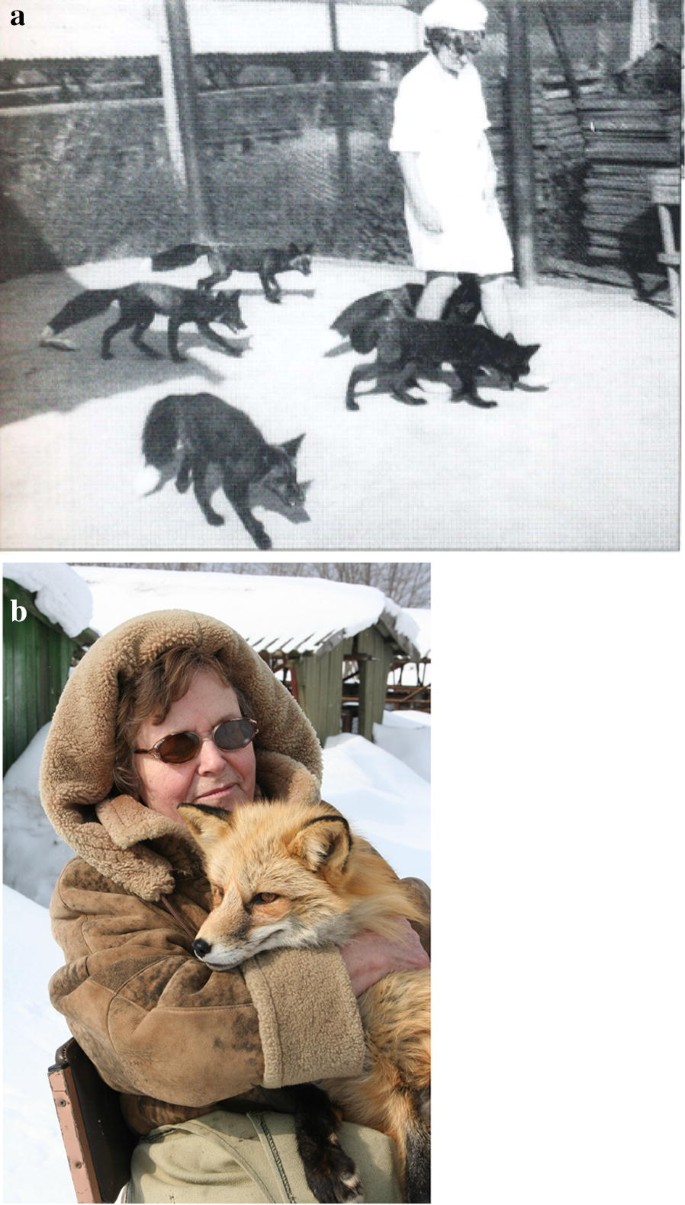
Lyudmila Trut. a 1960 and b 2015
It is not possible here to do justice to all of the results this almost six-decade-long experiment has produced. Here I touch on some of the most salient (see Trut 1999 , Trut et al. 2009 and Dugatkin and Trut 2017 for more). Starting from what amounted to a population of wild foxes, within six generations (6 years in these foxes, as they reproduce annually), selection for tameness, and tameness alone, produced a subset of foxes that licked the hand of experimenters, could be picked up and petted, whined when humans departed, and wagged their tails when humans approached. An astonishingly fast transformation. Early on, the tamest of the foxes made up a small proportion of the foxes in the experiment: today they make up the vast majority.
Belyaev was correct that selection on tameness alone leads to the emergence of traits in the domestication syndrome. In less than a decade, some of the domesticated foxes had floppy ears and curly tails (Fig. 2 ). Their stress hormone levels by generation 15 were about half the stress hormone (glucocorticoid) levels of wild foxes. Over generations, their adrenal gland became smaller and smaller. Serotonin levels also increased, producing “happier” animals. Over the course of the experiment, researchers also found the domesticated foxes displayed mottled “mutt-like” fur patterns, and they had more juvenilized facial features (shorter, rounder, more dog-like snouts) and body shapes (chunkier, rather than gracile limbs) (Fig. 3 ). Domesticated foxes like many domesticated animals, have longer reproductive periods than their wild progenitors. Another change associated with selection for tameness is that the domesticated foxes, unlike wild foxes, are capable of following human gaze as well as dogs do (Hare et al. 2005 ). In a recent paper, a “hotspot” for changes associated with domestication has been located on fox chromosome 15 (Kukekova et al. 2018 ). SorCS , one gene in this hotspot, is linked with synaptic plasticity, which itself is associated with memory and learning, and so together these studies are helping us better understand how the process of domestication has led to important changes in cognitive abilities.
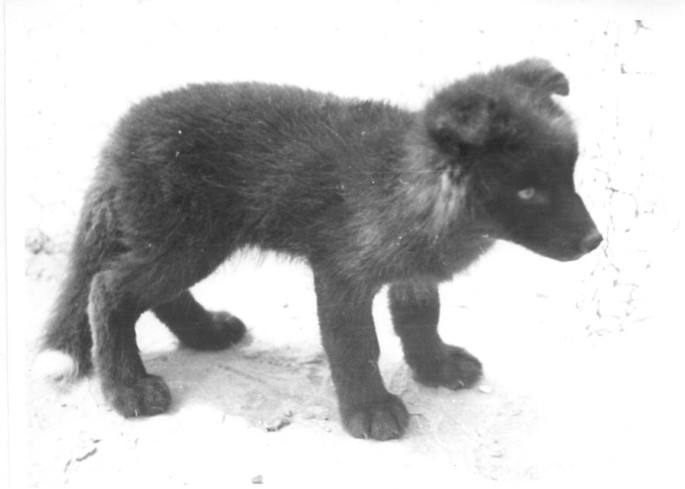
Mechta (Dream), the first of the domesticated foxes to have floppy ears 1969
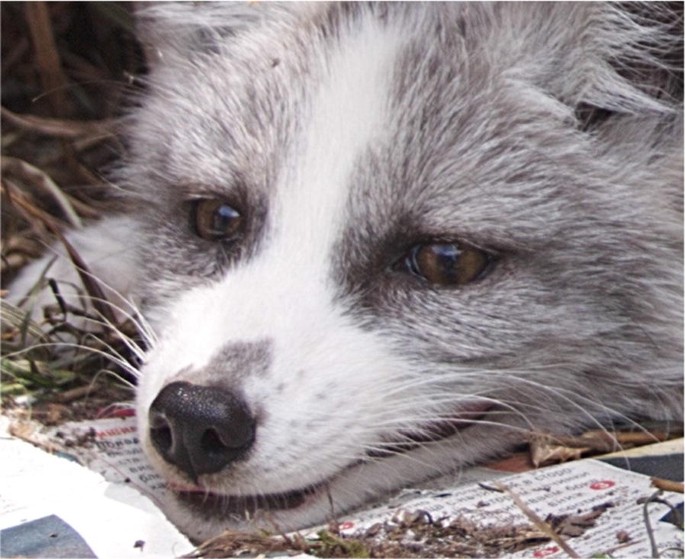
The domesticated foxes have more juvenilized facial characters, including a shorter, rounder snout, than wild foxes
Right from the start of the experiment, Belyaev hypothesized that the process of domestication was in part the result of changes in gene expression patterns—when genes “turn on” and “turn off” and how much protein product they produce. A recent study examining expression patterns at the genome level, in both domesticated foxes and a second line of foxes that has been under long-term selection for aggressive, rather than tame, behavior, suggests Belyaev was correct (Wang et al. 2018 ). This study identified more than one hundred genes in the prefrontal cortex of the brain that showed different gene expression patterns between domesticated and aggressive foxes. Some of those genes are linked to serotonin receptor pathways that modulate behavioral temperament, including tame and aggressive temperaments.
When Belyaev proposed that the domestication syndrome was linked to tame behavior, he did not have a proposed mechanism, but today we are getting closer to understanding how this works. Very early on in animal development, what are known as neural crest cells migrate from the neural crest to a plethora of locations: glands in the endocrine system, bone, fur, cartilage, the brain and other spots in a developing embryo. The neural crest cell hypothesis for the domestication syndrome proposes that selection for tame behavior results in a reduction of the number of migrating neural crest cells, which subsequently leads to changes in fur coloration, facial structure, the strength of cartilage (floppy ears, curly tails and so on), hormone levels, the length of the reproductive season, and more. This hypothesis may provide the link that Belyaev was missing when he came up with the idea for the experiment (Wilkins et al. 2014 ).
Discussion: a cautionary tale
The silver fox domestication study is often lauded as one of the most important long-term studies ever undertaken in biology. Yet in 1959, the very year it commenced, the work came within a hair’s breath of being shut down by the premier of the Soviet Union. The problem for Belyaev and Trut was that their domestication experiment, like any experiment in domestication, was an experiment in genetics. But work in Mendelian genetics was essentially illegal at the time in the Soviet Union, because of a pseudo-scientific charlatan by the name of Trofim Lysenko (Joravsky 1979 ; Soyfer 1994 ).
In the mid-1920s, the Communist Party leadership, in an attempt to glorify the average citizen, began to promote uneducated men from the proletariat into the scientific community. Lysenko was one of those men. The son of peasant farmers in the Ukraine, Lysenko didn’t learn how to read until he was a teenager, and his education, as it was, amounted to a correspondence degree from gardening school. With no training, he still landed a middle-level job at the Gandzha Plant Breeding Laboratory in Azerbaijan in 1925. Lysenko convinced a Pravda reporter, who was writing a story about the regime’s glorious peasant scientists, that the yield from his pea crop he tended was far above average, and that his technique could save a starving USSR. In the Pravda article the reporter wrote glowingly that “the barefoot professor Lysenko has followers… and the luminaries of agronomy visit… and gratefully shake his hand.” Pure fiction, but the story propelled Lysenko to the national limelight, with Josef Stalin taking pride in what he read.
Over time Lysenko would claim to have done experiments creating grain crops, including wheat and barley, that produced high yields during cold periods of the year, if their seeds had been kept in freezing water for long stretches before planting. What’s more, Lysenko claimed offspring of these plants would also produce higher yields, down through the generations. This method, he said, could quickly double the yield of farmlands in the Soviet Union in just a few years. In truth, Lysenko never undertook any legitimate experiments on increased crop yield. Any “data” he claimed to have produced he simply fabricated.
Soon Stalin was his ally, and Lysenko began a crusade to discredit work in Mendelian genetics because proof of the genetic theory of evolution would likely expose him as a fraud. He denounced geneticists, both overseas and in the Soviet Union, as subversives. His star was rising and at a conference held at the Kremlin in 1935, after Lysenko finished a speech in which he branded Western geneticists as “saboteurs,” Stalin stood up to yell, “Bravo, Comrade Lysenko, bravo.”
Lysenko was placed in charge of all policy regarding the biological sciences in July 1948. The next month, at a meeting of the All-Union Lenin Academy of Agricultural Sciences, he presented a talk that today is regarded as the most disingenuous, dangerous speech in the history of Soviet science. In this speech, “The Situation in the Science of Biology,” Lysenko damned “modern reactionary genetics,” by which he meant Mendelian genetics. At the end of his ranting, the audience cheered wildly. Geneticists present were forced to stand up and refute their scientific knowledge and practices. If they refused, they were thrown out of the Communist Party. In the aftermath of that awful speech thousands of geneticists were fired from their jobs. Dozens, perhaps hundreds, were jailed, and a few were murdered by Lysenko’s henchmen.
Belyaev could not sit by idly. After reading of Lysenko’s speech in the newspaper, he was furious. His wife, Svetlana, remembers it well: “Dmitri was walking toward me with tough sorrowful eyes, restlessly bending and bending the newspaper in his hands.” Another colleague recalls running into him that day and how Belyaev had fumed that Lysenko was “a scientific bandit” (Dugatkin and Trut 2017 ). Ignoring the personal risk, Belyaev began speaking out about the dangers of Lysenkoism to all scientists, whether friend or foe.
The case of Nikolai Vavilov, one of Belyaev’s intellectual idols, illustrates just how dangerous it was to speak out against Lysenko (Medvedev 1969 ; Pringle 2008 ; Soyfer 1994 ). Vavilov studied plant domestication and was also one of the world’s leading botanical explorers, travelling to sixty-four countries collecting seeds. In his lifetime alone, three terrible famines in Russia killed millions of people and Vavilov had dedicated his life to finding ways to propagate crops for his country. His research program centered on finding crop varieties that were less susceptible to disease.
Vavilov’s collecting trips are the stuff of legend. On one of three expeditions, he was arrested at the Iran-Russia border and accused of being a spy, simply because he had a few German botany books with him. On another trip, this one to the border of Afghanistan, he fell as he was stepping between two train cars, and was left dangling by his elbows as the train roared along. On yet a different a trip to Syria he contracted malaria and typhus.
Vavilov collected more live plant specimens than any man or woman in history, and he set up hundreds of field stations for others to continue his work.
Vavilov had actually befriended the young Lysenko in the 1920s, before it became clear that Lysenko was a malevolent charlatan. Over time, Vavilov became suspicious of Lysenko’s results, and in a series of experiments trying to replicate what Lysenko said he had discovered, Vavilov proved to himself, and others that were willing to listen (though not many were), that Lysenko was a fraud. He then became Lysenko’s most fearless opponent. In retaliation, Stalin forbade Vavilov from any more travels abroad and he was denounced in the government newspaper, Pravda . Lysenko warned Vavilov that “when such erroneous data were swept away… those who failed to understand the implications” would also be “swept away.” Vavilov was undeterred, and at a meeting of the All-Union Institute of Plant Breeding declared, “We shall go into the pyre, we shall burn, but we shall not retreat from our convictions.”
In 1940, Vavilov was kidnapped up by four men wearing dark suits and thrown into the KGB’s dreaded Lubyanka Prison in Moscow. Next he was shipped off to an even more remote prison. There, over the course of 3 years, the man who had collected 250,000 domesticated plant samples to solve the puzzle of famine in his homeland was slowly starved to death.
Lysenko’s power had its ebbs and flows. In 1959, as the fox domestication experiment was just beginning, Lysenko was getting frustrated that his hold on Soviet biology was loosening. Something needed to be done. And The Institute of Cytology and Genetics, where the fox domestication experiment had just begun, where Belyaev was vice director, and where they had the audacity to put “Genetics” in the title of the institute, seemed a good place to attack.
The Institute of Cytology and Genetics was part of a new giant scientific city called Akademgorodok. Long before this city was built, Russian writer Maxim Gorky had written of a fictional “town of science… a series of temples in which every scientist is a priest… where scientists every day fearlessly probe deeply into the baffling mysteries surrounding our planet.” Here Gorky envisioned “…foundries and workshops where people forge exact knowledge, facet the entire experience of the world, transforming it into hypotheses, into instruments for the further quest of the truth.” Akademgorodok was what Gorky had in mind. It was home to thousands of scientists housed at the Institute of Cytology and Genetics, the Institute of Mathematics, the Institute of Nuclear Physics, the Institute of Hydrodynamics, and a half dozen other institutes.
In January 1959, a Lysenko-created committee from Moscow was sent to Akademgorodok. This committee had been authorized to determine just what sort of work was being done at the Institute of Cytology and Genetics, and Belyaev, Trut and their colleagues understood the gravity of the situation. “Committee members were, Trut said, “snooping in the laboratories,” and rumors were spreading that the committee was unhappy. When the committee met with Mikhail Lavrentyev, chief of all the institutes at Akademgorodok, they told him that “the direction of the Institute of Cytology and Genetics is methodologically wrong” (Dugatkin and Trut 2017 ). Ominous words from a Lysenkoist group.
Nikita Khrushchev, premier of the USSR, learned of the committee’s report about Akademgorodok. Khrushchev was a supporter of Lysenko, and he decided to see for himself what was happening. In September 1959, while returning from a visit to Mao Tse-Tung in China, he stopped off in Novosibirsk and went to Akademgordok.
The staff of all the science institutes at Akademgorodok gathered for this visit, and Trut remembers that the premier “walked by the assembled staff very fast, not paying any attention to them” as he proceeded to a meeting with administrators. “Khrushchev” Trut recalls was, “very discontented, with the intention to get everyone in trouble because of the geneticists.” What Khrushchev and Akademgorodok administrators said that day was not recorded, but accounts from the time make clear that the premier intended to shut down the Institute of Cytology and Genetics that day, and with it the nascent silver fox domestication experiment.
Fortunately for science, Khrushchev’s daughter, Rada, was with him in Akademgorodok. Rada, a well-respected journalist, had trained as a biologist, and understood very well that Lysenko was a fraud. She somehow managed to convince her father to let the Institute of Cytology and Genetics remain open. In an ironic twist, because Khrushchev felt he had to do something to show his discontent, the day after his visit, he fired the head of the Institute of Cytology and Genetics. Deputy Director Belyaev was now in charge of the institute.
If Rada Khrushchev had not taken a stand for science that day the fox domestication study would likely have ended before it even got off the ground. But, it survived and thrived and continues to shed new light on the process of domestication.
Darwin C. The variation of animals and plants under domestication. London: J. Murray; 1868.
Google Scholar
Dugatkin LA, Trut LN. How to tame a fox (and build a dog). Chicago: University of Chicago Press; 2017.
Book Google Scholar
Hare B, Plyusnina I, Ignacio N, Schepina O, Stepika A, Wrangham R, Trut L. Social cognitive evolution in captive foxes is a correlated by-product of experimental domestication. Curr Biol. 2005;15:226–30.
Article CAS Google Scholar
Joravsky D. The Lysenko affair. Cambridge: Harvard University Press; 1979.
Kukekova AV, Johnson JL, Xiang X, Feng S, Liu S, Rando HM, Kharlamova AV, Herbeck Y, Serdyukova NA, Xiong Z, Beklemischeva V, Koepfli K-P, Gulevich RG, Vladimirova AV, Hekman JP, Perelman PL, Graphodatsky AS, Obrien SJ, Wang X, Clark AG, Acland GM, Trut LN, Zhang G. Red fox genome assembly identifies genomic regions associated with tame and aggressive behaviours. Nat Ecol Evol. 2018. https://doi.org/10.1038/s41559-018-0611-6 .
Article PubMed Google Scholar
Medvedev Z. The rise and fall of T.D. Lysenko: Columbia University Press; 1969.
Pringle P. The murder of Nikolai Vavilov. New York: Simon and Schuster; 2008.
Soyfer VN. Lysenko and the tragedy of Soviet science. Newark: Rutgers University Press; 1994.
Trut LN. Early canid domestication: the farm-fox experiment. Am Sci. 1999;87:160–9.
Article Google Scholar
Trut LN, Oskina I, Kharlamova A. Animal evolution during domestication: the domesticated fox as a model. BioEssays. 2009;31:349–60.
Wang X, Pipes L, Trut LN, Herbeck Y, Vladimirova AV, Gulevich RG, Kharlamova AV, Johnson JL, Acland GM, Kukekova AV, Clark AG. Genomic responses to selection for tame/aggressive behaviors in the silver fox ( Vulpes vulpes ). Proc Natl Acad Sci USA. 2018;115:10398–403.
Wilkins AS, Wrangham R, Fitch TW. The “domestication syndrome” in mammals: a unified explanation based on neural crest cell behavior and genetics. Genetics. 2014;197:795–808.
Download references
Authors’ contributions
The author read and approved the final manuscript.
Acknowledgements
I thank Lyudmila Trut for working with me on our book, How to Tame a Fox and Build a Dog (University of Chicago Press, 2017). Nikolai and Michael Belyaev provided much in the way of assistance, as did Aaron Dugatkin. I thank Dana Dugatkin for proofreading this paper.
Availability of data and materials
No primary data was included in this review.
Competing interests
The author declares no competing interests.
Publisher’s Note
Springer Nature remains neutral with regard to jurisdictional claims in published maps and institutional affiliations.
Author information
Authors and affiliations.
Department of Biology, University of Louisville, Louisville, KY, 40208, USA
Lee Alan Dugatkin
You can also search for this author in PubMed Google Scholar
Corresponding author
Correspondence to Lee Alan Dugatkin .
Rights and permissions
Open Access This article is distributed under the terms of the Creative Commons Attribution 4.0 International License ( http://creativecommons.org/licenses/by/4.0/ ), which permits unrestricted use, distribution, and reproduction in any medium, provided you give appropriate credit to the original author(s) and the source, provide a link to the Creative Commons license, and indicate if changes were made.
Reprints and permissions
About this article
Cite this article.
Dugatkin, L.A. The silver fox domestication experiment. Evo Edu Outreach 11 , 16 (2018). https://doi.org/10.1186/s12052-018-0090-x
Download citation
Received : 25 August 2018
Accepted : 26 November 2018
Published : 07 December 2018
DOI : https://doi.org/10.1186/s12052-018-0090-x
Share this article
Anyone you share the following link with will be able to read this content:
Sorry, a shareable link is not currently available for this article.
Provided by the Springer Nature SharedIt content-sharing initiative
- Domestication
- Silver foxes
Evolution: Education and Outreach
ISSN: 1936-6434
- Submission enquiries: [email protected]

What DNA From Pet Foxes Teaches Us About Dogs—And Humans
A Soviet-era experiment to breed tame and aggressive foxes has produced surprising revelations about social behavior and domestication.
For nearly 60 years, Russian scientists have bred foxes to be tame—or aggressive. A new study looking at the genomes of the two groups shows that the experiment has changed the animals’ DNA in surprising ways. The research has relevance for understanding social behavior across animals and even humans.
It took a while to get to here. In 1959, a man named Dmitri Belyaev began an experiment designed to understand how dogs became domesticated . Belyaev and other biologists believed that domestic dogs were descended from wolves, but did not yet know how all the anatomical, physiological, and behavioral differences between the two animals could arise.
But Belyaev had a hunch. He suspected that the key component was the dog's tameness. Perhaps, he hypothesized, the biological changes in domesticated animals—white spots, curled tails, floppy ears, shortened skulls—were the result of an evolutionary selection process over behavioral traits rather than anatomical ones.
Fearful and Friendly
Belyaev believed that by breeding the friendliest foxes with each other, perhaps he could domesticate them, artificially mimicking the millennia-long process through which wolves became dogs. He bought up a group of silver foxes from a Canadian fur farm and got to work at his lab in the Soviet Union. ( See also: These foxes ‘grow’ their own gardens .)
Belyaev would eventually prove himself right. Breeding the least fearful foxes with each other resulted not only in animals that were eager to seek out a social connection with humans, but also in animals that displayed the suite of anatomical features associated with domestication: those characteristic white spots, curly tails, floppy ears, and so on.
The entire collection of modifications associated with domestication could be brought about simply by breeding foxes according to their response when approached by a human. Would they approach the experimenter with curiosity and permit physical contact? Or would they back away, hissing and yelping out of fear?
Belyaev died in 1985, but the experiment continues today. Researchers have bred more than 40 generations of friendly and aggressive foxes. And now, for the first time, they have a fully sequenced fox genome to help understand the genetics that underlie the transition from wild to tame, as described in a study published today in the journal Nature Ecology and Evolution .

The researchers sequenced the genes of 10 foxes from the aggressive and tame populations, and assembled a complete genome of the silver fox ( Vulpes vulpes ). This has and will continue to allow them to find genetic differences that could underlie different aspects of domestication, says University of Illinois biologist Anna Kukekova , who led the study.
Until now, researchers have had to rely on the domestic dog genome as a reference. But while wolves and foxes diverged only 10 million years ago, dogs and foxes have dramatically different lifestyles. (Related: Why are dogs so friendly? Science has an answer. )
Genetic Secrets
Kukekova and her colleagues zeroed in on one of the 103 genomic regions that differed between the tame and aggressive foxes. This analysis found that the tamest foxes had a version of a gene called SorCS1 that did not appear in either the aggressive or conventionally-bred foxes. Meanwhile, a different version of SorCS1 most common in aggressive foxes was incredibly uncommon in the other groups.
There was no prior reason to suspect that SorCS1 was associated with social behavior. "It was known to be associated with autism and Alzheimer's disease [in humans]," says Kukekova. And a mouse study recently found that SorCS1 is involved in synapse formation and neuronal signaling. This paves the way for understanding how the gene might affect social behavior, she says.

Domesticated animals experience less stress than wild creatures when confronted with unfamiliar people or objects, and the paper turned up genes that may be involved in this behavioral difference, which is tied to a blunted response in the hypothalamic-pituitary-adrenal, or HPA, axis. This series of biological structures form a connection between the brain and endocrine systems in the body that activates in response to stress.
The study also turned up one genomic region of interest that has been associated with domestication in dogs and with Williams-Beuren syndrome in humans, a genetic condition associated with exceptionally friendly behavior. Surprisingly, though, the "Williams-Beuren region" shows up in the aggressive foxes, rather than the tame ones.
Kukekova points out that Williams-Beuren syndrome is also characterized by extreme anxiety, however, and that is indeed consistent with the foxes' more fearful response to humans. And Princeton University evolutionary biologist Bridgett von Holdt, who was not associated with the study, points out that some dogs can be incredibly aggressive, even if they develop strong, friendly bonds with their owners. To really sort out the subtleties, she adds, will require a lot more research.
Related Topics
- DOMESTIC DOGS
You May Also Like

Meet ‘Dogxim,’ the world’s first known dog-fox hybrid—and a genetic oddity

What’s the real difference between a mutt and a designer dog?

Dog DNA tests are on the rise—but are they reliable?

Why do big dogs die young?

Who was the Coast Salish woolly dog? DNA testing provides some clues.
- Terms of Use
- Privacy Policy
- Your US State Privacy Rights
- Children's Online Privacy Policy
- Interest-Based Ads
- About Nielsen Measurement
- Do Not Sell or Share My Personal Information
- Nat Geo Home
- Attend a Live Event
- Book a Trip
- Inspire Your Kids
- Shop Nat Geo
- Visit the D.C. Museum
- Learn About Our Impact
- Support Our Mission
- Advertise With Us
- Customer Service
- Renew Subscription
- Manage Your Subscription
- Work at Nat Geo
- Sign Up for Our Newsletters
- Contribute to Protect the Planet
Copyright © 1996-2015 National Geographic Society Copyright © 2015-2024 National Geographic Partners, LLC. All rights reserved
Every print subscription comes with full digital access
Science News
Fox experiment is replaying domestication in fast-forward.
New book recounts nearly 60-year effort to understand taming process

DOMESTICATION IN ACTION How to Tame a Fox tells the story of a long-running experiment to domesticate silver foxes (a wild silver fox is shown).
Minette Layne/Flickr ( CC BY-NCE 2.0 )
Share this:
By Tina Hesman Saey
April 29, 2017 at 8:00 am

In 1959, Lyudmila Trut rode trains through Siberia to visit fox farms. She wasn’t looking for furs. She needed a farm to host an audacious experiment dreamed up by geneticist Dmitry Belyaev: to create a domestic animal as docile as a dog from aggressive, wily silver foxes.
Evolutionary biologist Lee Alan Dugatkin helps Trut recount this ongoing attempt to replay domestication in How to Tame a Fox . The mechanics of domestication are still a matter of intense scientific debate. Belyaev’s idea was that ancient humans picked wolves and other animals for docility and that this artificial selection jump-started an evolutionary path toward domestication.
Back in the 1950s, testing the idea was dangerous work, and not just because untamed foxes bite. In 1948, the Soviet Union, under the scientific leadership of Trofim Lysenko, outlawed genetics research. Lysenko had risen to power based on fabricated claims that freezing seeds in water could increase crop yields. “With Stalin as his ally, he launched a crusade to discredit work in genetics, in part, because proof of the genetic theory of evolution would expose him as a fraud,” Dugatkin and Trut write. Geneticists often lost their jobs, were jailed or even killed, as was Belyaev’s own brother. So Belyaev cloaked his domestication experiments in the guise of improving the fur-farming business.
Fox researchers started by testing the temperament of about 100 silver foxes each year. About a dozen of the foxes, slightly calmer than most, were bred annually. Within a few generations, some foxes were a bit more accepting of people than the starting population. That small difference convinced Belyaev of the experiment’s promise, and he recruited Trut to carry out a larger breeding program.

Trut and Dugatkin lovingly recount some of the experiment’s milestones, including the first fox born with a wagging tail and the first one with droopy ears — two hallmarks of domesticated animals. Trut recalls the foxes she’s lived with and, heartbreakingly, the ones she lost, or had to sacrifice to keep the experiment going after the collapse of the Russian economy in 1998 led to funding problems. At every step, the authors skillfully weave the science of domestication into the narrative of foxes becoming ever-more doglike.
Trut has kept Belyaev’s dream alive for nearly 60 years. Now in her 80s, she still runs the experiment and has eagerly collaborated with others to squeeze every drop of knowledge from the project. The work has shown that selecting for tameness alone can also produce a whole suite of other changes (curly tails, droopy ears, spotted coats, juvenile facial features) dubbed the domestication syndrome. With the help of geneticist Anna Kukekova, Trut is searching for the genes involved in this process.
The project now sells some of the foxes as pets to raise money, although one could argue they aren’t fully domesticated. The foxes may wag their tails and flop on their backs to get their bellies rubbed, but Trut says they still don’t follow commands like dogs do. It probably took Stone Age humans hundreds or thousands of years to domesticate wolves. The silver fox experiment has replayed the process in fast-forward. It may speed scientists’ quest to understand the DNA changes that transformed a wolf into a dog.
Buy How to Tame a Fox (and Build a Dog) from Amazon.com. Sales generated through the links to Amazon.com contribute to Society for Science & the Public’s programs.
More Stories from Science News on Science & Society

The ‘Does It Fly?’ podcast separates fact from science fiction

Is U.S. democracy in decline? Here’s what the science says

There’s a new term for attempting to own the wind: ventography

The fruit fly revolutionized biology. Now it’s boosting science in Africa


‘Night Magic’ invites you to celebrate the living wonders of the dark

This researcher studies how misinformation seeps into science and politics

10 early-career scientists tackling some of the biggest problems of today

Talking to a chatbot may weaken someone’s belief in conspiracy theories
Subscribers, enter your e-mail address for full access to the Science News archives and digital editions.
Not a subscriber? Become one now .
The Silver Fox Domestication Experiment
How to Tame a Fox and Build a Dog
- General Article
- Published: 30 September 2020
- Volume 25 , pages 987–1000, ( 2020 )
Cite this article

- Lee Alan Dugatkin ORCID: orcid.org/0000-0002-3171-8037 1
465 Accesses
Explore all metrics
For the last sixty years, a team of Russian geneticists have been running one of the most important biology experiments of the 20th, and now 21st, century. Each year they have selected the calmest foxes—foxes that are most prosocial to humans—to mimic the early stages of domestication. After providing an overview of how the silver fox domestication study began, I will discuss: 1) work on social cognition in the domesticated silver foxes, 2) work on the molecular genetics of domestication in the silver foxes, including work on changes in allele frequencies and changes in gene expression patterns, 3) a new hypothesis for how selection on tameness leads to the domestication syndrome via changes in the number and migration patterns of neural crest cells very early on in development, and 4) how the silver fox domestication experiment has led to new hypotheses about self-domestication in primates, including humans.
This is a preview of subscription content, log in via an institution to check access.
Access this article
Subscribe and save.
- Get 10 units per month
- Download Article/Chapter or eBook
- 1 Unit = 1 Article or 1 Chapter
- Cancel anytime
Price includes VAT (Russian Federation)
Instant access to the full article PDF.
Rent this article via DeepDyve
Institutional subscriptions
Similar content being viewed by others

Revisiting the famous farm foxes: A psychological perspective

The silver fox domestication experiment

Feralisation—The Understudied Counterpoint to Domestication
Suggested reading.
C Darwin, The Variation of Animals and Plants Under Domestication , Vol.1–2 (J. Murray, 1868).
L A Dugatkin and L N Trut, How to Tame a Fox and Build a Dog , University of Chicago Press, 2017.
S Deshpande, Magic of Transforming a Fox Into a Dog !, Resonance , Vol.23, No.8, pp.925–927, 2018.
Article Google Scholar
B Hare, M Brown, C Williamson, and M Tomasello, The domestication of social cognition in dogs, Science , 298, pp.1634–1636, 2002, doi: https://doi.org/10.1126/science.1072702 .
B Hare et al., Social cognitive evolution in captive foxes is a correlated byproduct of experimental domestication, Current Biology , 15, pp.226–230, 2005.
A V Kukekova et al., Mapping loci for fox domestication: Deconstruction/reconstruction of a behavioural phenotype, Behavior Genetics , 41, pp.593–606, 2011, doi: https://doi.org/10.1007/s10519-010-9418-1 .
B M von Holdt et al., Genome-wide SNP and haplotype analyses reveal a rich history underlying dog domestication, Nature , 464, pp.898–U109, 2010, doi: https://doi.org/10.1038/nature08837 .
A S Wilkins, R W Wrangham, and W Tecumseh Fitch, The “Domestication Syndrome” in mammals: A unified explanation based on neural crest cell behavior and genetics, Genetics , 197, pp.795–808, 2014.
D K Belyaev in Genetics: New Frontiers:Proceedings of the XV International Congress of Genetics (ed V.L. Chopra), pp.379–386 (Oxford University Press, 1984).
D K Belyaev, On some factors in the evolution of hominids Voprosy Filosofii , 8, pp.69–77 1981.
Google Scholar
B Hare, V Wobber, and R Wrangham, The self-domestication hypothesis: evolution of bonobo psychology is due to selection against aggression, Animal Behaviour , 83, pp.573–585, 2012, doi: https://doi.org/10.1016/j.anbehav.2011.12.007 .
Download references
Acknowledgements
I thank Lyudmila Trut for working with me on our book, How to Tame a Fox and Build a Dog (University of Chicago Press, 2017). Nikolai and Michael Belyaev provided much in the way of assistance, as did Aaron Dugatkin. I thank Dana Dugatkin for proofreading this article.
Author information
Authors and affiliations.
University of Louisville, Louisville, KY, 40292, USA
Lee Alan Dugatkin
You can also search for this author in PubMed Google Scholar
Corresponding author
Correspondence to Lee Alan Dugatkin .
Additional information
Lee Alan Dugatkin is an evolutionary biologist and a historian of science in the Department of Biology at the University of Louisville. He is the author of nine books and more than 150 papers, in such Journals as Nature, The Proceedings of the National Academy of Sciences , and The Proceedings of the Royal Society of London , and is a contributing author to Scientific American, The American Scientist, The New Scientist , and The Washington Post .
Rights and permissions
Reprints and permissions
About this article
Dugatkin, L.A. The Silver Fox Domestication Experiment. Reson 25 , 987–1000 (2020). https://doi.org/10.1007/s12045-020-1014-y
Download citation
Published : 30 September 2020
Issue Date : July 2020
DOI : https://doi.org/10.1007/s12045-020-1014-y
Share this article
Anyone you share the following link with will be able to read this content:
Sorry, a shareable link is not currently available for this article.
Provided by the Springer Nature SharedIt content-sharing initiative
- domestication
- natural selection
- Find a journal
- Publish with us
- Track your research
Cornell Chronicle
- Architecture & Design
- Arts & Humanities
- Business, Economics & Entrepreneurship
- Computing & Information Sciences
- Energy, Environment & Sustainability
- Food & Agriculture
- Global Reach
- Health, Nutrition & Medicine
- Law, Government & Public Policy
- Life Sciences & Veterinary Medicine
- Physical Sciences & Engineering
- Social & Behavioral Sciences
- Coronavirus
- News & Events
- Public Engagement
- New York City
- Photos of the Week
- Big Red Sports
- Freedom of Expression
- Student Life
- University Statements
- Around Cornell
- All Stories
- In the News
- Expert Quotes
- Cornellians
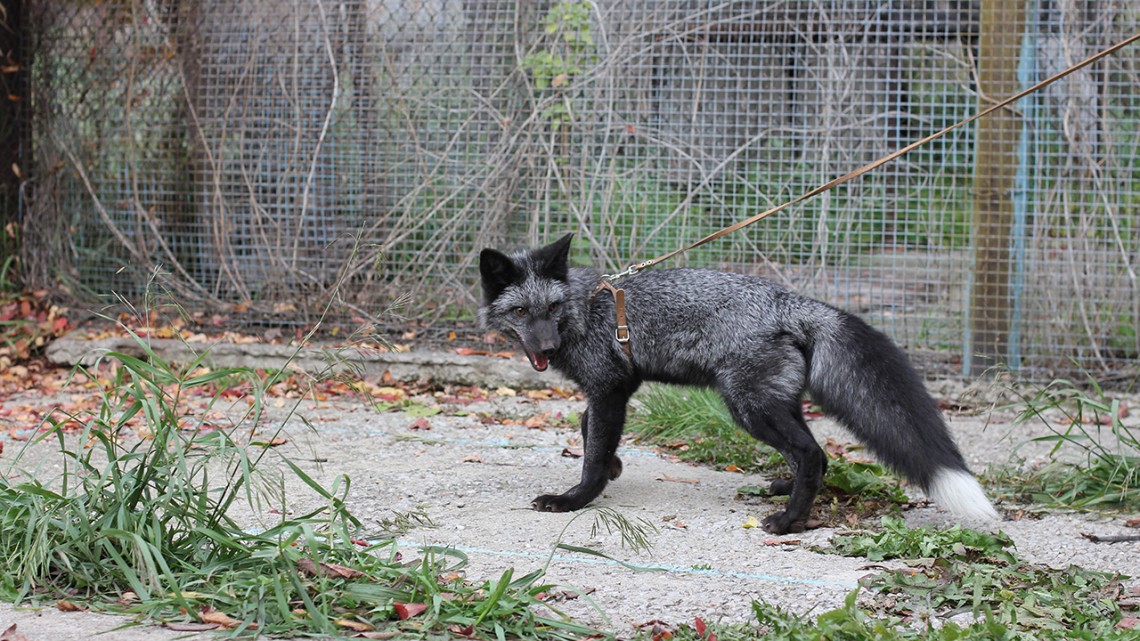
A silver fox bred for tameness at the the Institute for Cytology and Genetics in Novosibirsk, Russia.
Silver fox study reveals genetic clues to social behavior
By krishna ramanujan.
In 1959, Russian scientists began an experiment to breed a population of silver foxes, selecting and breeding foxes that exhibited friendliness toward people. They wanted to know if they could repeat the adaptations for tameness that must have occurred in domestic dogs. Subsequently they also bred another population of foxes for more aggressive behavior.
After 10 generations, a small fraction of the tame-bred foxes displayed dog-like domesticated behavior when people approached. Over time, an increasing fraction of the foxes showed this friendly behavior.
Now, after more than 50 generations of selective breeding, a new Cornell-led study compares gene expression of tame and aggressive silver foxes in two areas of the brain, shedding light on genes responsible for social behavior.
The study, published online Sept. 18 in the Proceedings of the National Academy of Sciences , identified genes that were altered in tame animals in two areas of the brain involved with learning and memory.
“That such a radical change in temperament could be accomplished so quickly is truly remarkable,” said Andrew Clark, professor in the Department of Molecular Biology and Genetics at Cornell and a senior co-author of the paper.
The research team obtained prefrontal cortex and basal forebrain brain tissue samples of 12 tame and 12 aggressive foxes from the Institute for Cytology and Genetics in Novosibirsk, Russia, where the foxes were bred.
Clark and first author Xu Wang, Ph.D. ’11, a former research associate in Clark’s lab, conducted two types of genetic analysis. In one investigation, they sequenced the RNA produced by all genes, which allowed them to measure how much every gene was turned on. The other test identified different versions of genes, called alleles, and measured how they changed in frequency in the population over generations.
These analyses revealed which brain pathways were altered by breeding tame and aggressive foxes. The prefrontal cortex and basal forebrains are known for handling higher processing of information, including higher-level social interaction. The team was especially interested in neurons classified by the neurotransmitters (brain signaling chemicals) they release: dopamine, serotonin and glutamine.
The pleasure centers in the brain are triggered by dopamine, and Clark said he expected those dopaminergic pathways to be altered in the tame animals.
“Tame animals seem like they are blissed out all the time,” he said. “They’re just so happy and adorable, so I thought certainly the dopaminergic [pathway would be affected]. But there was no signal.”
However, the genes that impact the function of both serotonergic neurons and glutaminergic neurons were clearly affected by selection toward tameness. These neurons are important for learning and memory.
Also, the analyses implicated genes important in the function of the neural crest, a transient group of cells that arises very early in the embryo. These cells migrate to form many types of adult cells, including those that determine skin and hair pigment (melanocytes), peripheral nerves, and the tissues of the face. The signals suggest a link to “domestication syndrome,” a cluster of ancillary traits – white fur spots, shorter nose, curly tail and floppy ears – that pops up in domesticated canines, and in similar forms of other species.
“Darwin, and many others since, observed that when people select for domestication, there is a tendency to see a reversion in these traits to a more juvenile form,” Clark said, adding that more study of the neural crest’s role in domestication syndrome is needed.
The paper was written in tandem with another related study recently published in Nature Ecology and Evolution (NEE) that includes many of the same co-authors, including Clark, Wang, Lyudmila Trut, co-director at the Institute for Cytology and Genetics, and Anna Kukekova, the NEE paper’s first author and an assistant professor in the Department of Animal Sciences at the University of Illinois. Kukekova has worked with Trut’s lab in Novosibirsk, and is a former research scientist at Cornell’s Baker Institute for Animal Health.
Media Contact
Get Cornell news delivered right to your inbox.
You might also like

Gallery Heading
- The Magazine
- Stay Curious
- The Sciences
- Environment
- Planet Earth
How a Russian Scientist Bred the First Domesticated Foxes

In just five decades, an experiment in Russia has accomplished something that took ancient humans thousands of years.
On a farm in Novosibirsk, Russian geneticist Dmitry K. Belyaev selectively bred hundreds of foxes over multiple generations, eventually creating something never seen before: a domesticated fox. His goal was to recreate the process by which humans gradually turned wild dogs into workers and friends, hopefully learning something about the mechanism of domestication in the process.
Nice Foxes Only
To accomplish his goal, he selected the most docile foxes he could find from fur farms around Russia. He then bred them in successive generations, each time choosing only the tamest individuals. This is similar to the process today by which dog breeders select for desired traits, or how ancient farmers cultivated hardy crops with the highest yields.
Belyaev found that the process worked for fox domestication as well. His experiment started in the late 1950s, and by the early 2000s almost all of the foxes on the farm displayed remarkable changes in behavior, according to an in-depth report penned by Lucy Jones of the BBC .
Foxes are considered notably hard to tame, but Belyaev’s foxes seemed preternaturally easygoing. They looked more like dogs than wild foxes — they would wag their tails and perk up in the presence of humans, and displayed none of the skittishness or aggressiveness usually associated with wild animals. In addition, they enjoyed being petted and would lick their handlers faces — all behaviors that socialized dogs display. And, all of this happened without any training on the part of the researchers. Their only intervention was to selectively breed those foxes that fit in with humans the best.
NPR spoke to Ceiridwen Terrill, a professor of Science Writing and Environmental Journalism at Concordia University in Portland, Oregon, who visited the farm and even got to pet the foxes.
“They’re genetically designed to crave human contact,” she says, “so that fox loved having its belly scratched.”
It wasn’t only behavioral changes either. The foxes started to look different over time: their ears got floppier, their legs, tails and snouts got shorter and their skulls got wider. Even their breeding patterns changed, they now mated out of season and had on average one more offspring per litter.
Changes Beyond Behavior
The reasons for this are likely rooted in neurological and endocrinological changes wrought in the foxes through selective breeding, according to a 2009 paper by Lyudmila Trut, of the Institute of Cytology and Genetics at the Russian Academy of Sciences, who now oversees the farm.
That paper reviewed the changes caused by domestication and found that, compared to wild foxes, the domesticated animals displayed different levels of certain chemicals in their brains. For example, their adrenal glands are not as active, but they have higher levels of serotonin. Serotonin likely plays a role in mediating aggressive behavior, writes Trut.
The physical alterations in the foxes, similar to the changes that happened in dogs, are likely a byproduct of behavioral selection. The droopiness of their ears may be caused by the slowing of their adrenal glands, says the BBC , and the others physical disparities could similarly be related to the differences in hormone levels that lead to desirable traits. Dogs likely went through much the same process over the course of hundreds of generations as they gradually adapted to living with us.
Belyaev’s experiment is evidence that our theories of domestication are spot-on; we’ve bent the arc of evolution toward in our favor. Moreover, the process of taming a species affects more than their behavior, domestication alters their looks, and changes the rhythms of their lives.
Swing over to the BBC and check out Jones’s entire story , for more details about this decades-long study.
Already a subscriber?
Register or Log In

Keep reading for as low as $1.99!
Sign up for our weekly science updates.
Save up to 40% off the cover price when you subscribe to Discover magazine.

Clark lab silver fox study reveals genetic clues to social behavior
9/20/2018 By | Krishna Ramanujan , Cornell Chronicle
In 1959, Russian scientists began an experiment to breed a population of silver foxes, selecting and breeding foxes that exhibited friendliness toward people. They wanted to know if they could repeat the adaptations for tameness that must have occurred in domestic dogs. Subsequently they also bred another population of foxes for more aggressive behavior.
After 10 generations, a small fraction of the tame-bred foxes displayed dog-like domesticated behavior when people approached. Over time, an increasing fraction of the foxes showed this friendly behavior.
Now, after more than 50 generations of selective breeding, a new Cornell-led study compares gene expression of tame and aggressive silver foxes in two areas of the brain, shedding light on genes responsible for social behavior.
The study, published online Sept. 18 in the Proceedings of the National Academy of Sciences , identified genes that were altered in tame animals in two areas of the brain involved with learning and memory.
“That such a radical change in temperament could be accomplished so quickly is truly remarkable,” said Andrew Clark , professor in the Department of Molecular Biology and Genetics at Cornell and a senior co-author of the paper.
The research team obtained prefrontal cortex and basal forebrain brain tissue samples of 12 tame and 12 aggressive foxes from the Institute for Cytology and Genetics in Novosibirsk, Russia, where the foxes were bred.
Clark and first author Xu Wang, Ph.D. ’11, a former research associate in Clark’s lab, conducted two types of genetic analysis. In one investigation, they sequenced the RNA produced by all genes, which allowed them to measure how much every gene was turned on. The other test identified different versions of genes, called alleles, and measured how they changed in frequency in the population over generations.
These analyses revealed which brain pathways were altered by breeding tame and aggressive foxes. The prefrontal cortex and basal forebrains are known for handling higher processing of information, including higher-level social interaction. The team was especially interested in neurons classified by the neurotransmitters (brain signaling chemicals) they release: dopamine, serotonin and glutamine.
The pleasure centers in the brain are triggered by dopamine, and Clark said he expected those dopaminergic pathways to be altered in the tame animals.
“Tame animals seem like they are blissed out all the time,” he said. “They’re just so happy and adorable, so I thought certainly the dopaminergic [pathway would be affected]. But there was no signal.”
However, the genes that impact the function of both serotonergic neurons and glutaminergic neurons were clearly affected by selection toward tameness. These neurons are important for learning and memory.
Also, the analyses implicated genes important in the function of the neural crest, a transient group of cells that arises very early in the embryo. These cells migrate to form many types of adult cells, including those that determine skin and hair pigment (melanocytes), peripheral nerves, and the tissues of the face. The signals suggest a link to “domestication syndrome,” a cluster of ancillary traits – white fur spots, shorter nose, curly tail and floppy ears – that pops up in domesticated canines, and in similar forms of other species.
“Darwin, and many others since, observed that when people select for domestication, there is a tendency to see a reversion in these traits to a more juvenile form,” Clark said, adding that more study of the neural crest’s role in domestication syndrome is needed.
The paper was written in tandem with another related study recently published in Nature Ecology and Evolution (NEE) that includes many of the same co-authors, including Clark, Wang, Lyudmila Trut, co-director at the Institute for Cytology and Genetics, and Anna Kukekova, the NEE paper’s first author and an assistant professor in the Department of Animal Sciences at the University of Illinois. Kukekova has worked with Trut’s lab in Novosibirsk, and is a former research scientist at Cornell’s Baker Institute for Animal Health.
This article originally appeared in the Cornell Chronicle .

Understanding freshwater soundscapes in the Brazilian Amazon

EEB grad student in the spotlight: Stephanie Tran

EEB researchers receive Cornell Atkinson Academic Venture Funds

Are plants intelligent? It depends on the definition
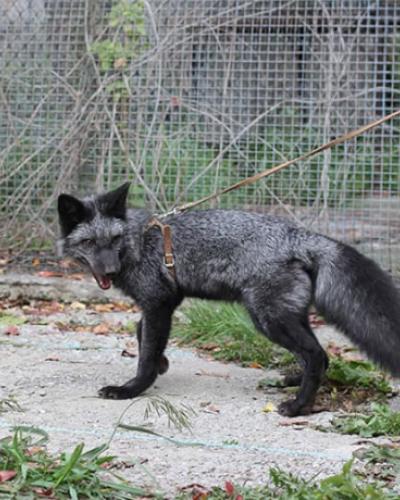

IMAGES
COMMENTS
The silver fox is a melanistic form of the wild red fox. Domesticated silver foxes are the result of an experiment designed to demonstrate the power of selective breeding to transform species, as described by Charles Darwin in On the Origin of Species. [1]
The impressively long silver fox experiment, ongoing at the Russian Academy of Sciences’ Institute of Cytology and Genetics in Novosibirsk since 1960, didn’t seek to breed foxes that looked so...
Early on, the tamest of the foxes made up a small proportion of the foxes in the experiment: today they make up the vast majority. Belyaev was correct that selection on tameness alone leads to the emergence of traits in the domestication syndrome.
For nearly 60 years, Russian scientists have bred foxes to be tame—or aggressive. A new study looking at the genomes of the two groups shows that the experiment has changed the animals’ DNA...
How to Tame a Fox recounts a nearly 60-year experiment in Russia to domesticate silver foxes.
How to Tame a Fox and Build a Dog∗. been running one of the most important biology experiments of the 20th, and now 21st, century. Each year they have selected the calmest foxes—foxes that are most prosocial to humans—to mimic the early stages of domestication.
Now, after more than 50 generations of selective breeding, a new Cornell-led study compares gene expression of tame and aggressive silver foxes in two areas of the brain, shedding light on genes responsible for social behavior.
A decades-long experiment on taming silver foxes informed a key theory about animal domestication that is now being called into question. (Monty Sloan / Wolf Pack) By Jason Bittel. December 3,...
On a farm in Novosibirsk, Russian geneticist Dmitry K. Belyaev selectively bred hundreds of foxes over multiple generations, eventually creating something never seen before: a domesticated fox. His goal was to recreate the process by which humans gradually turned wild dogs into workers and friends, hopefully learning something about the ...
Now, after more than 50 generations of selective breeding, a new Cornell-led study compares gene expression of tame and aggressive silver foxes in two areas of the brain, shedding light on genes responsible for social behavior.